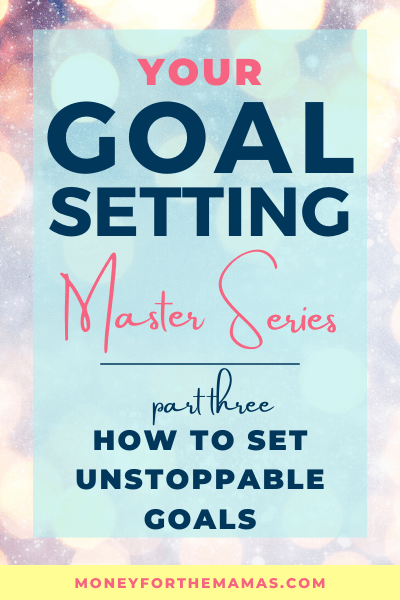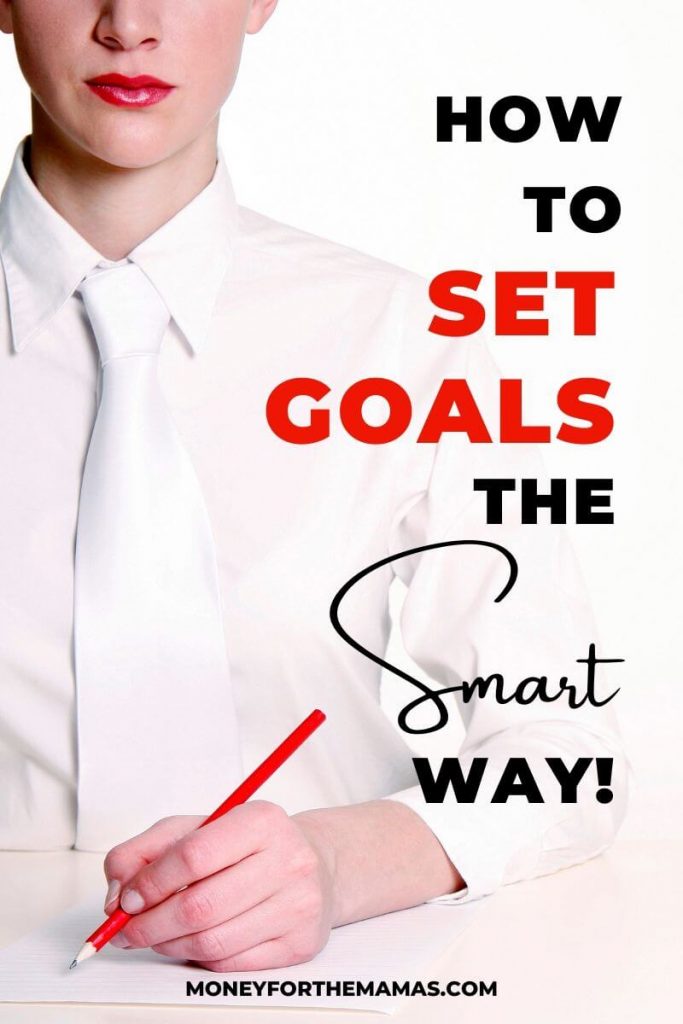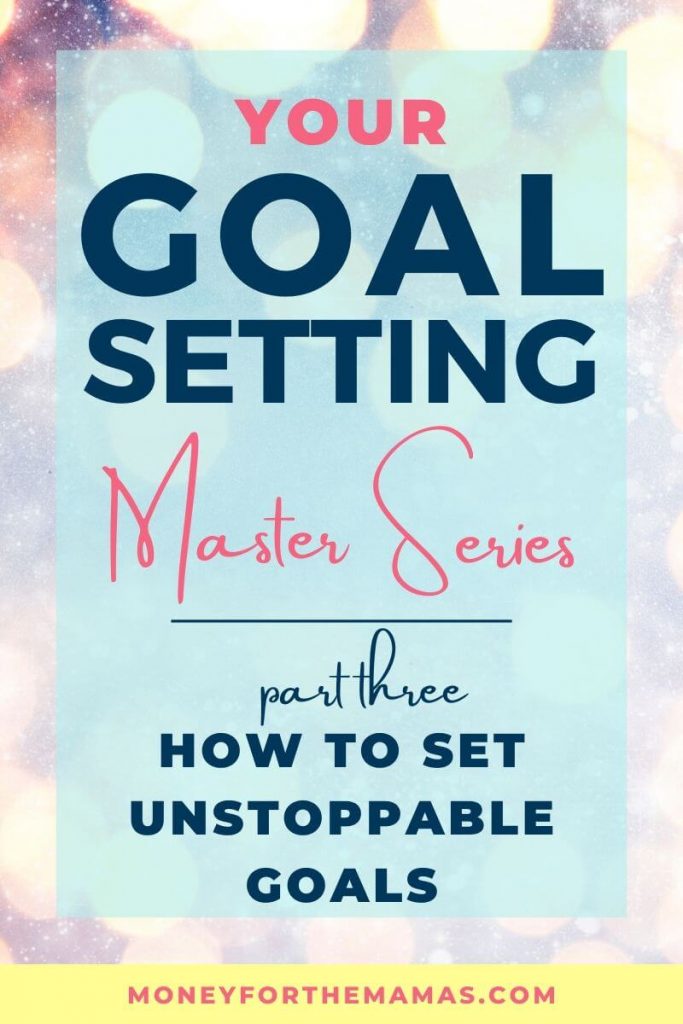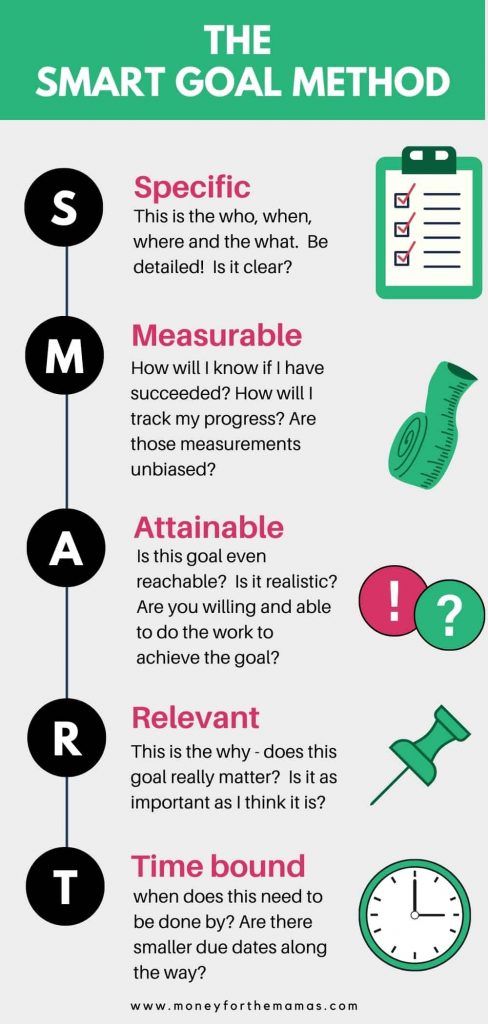How to Make SMART goals & be Unstoppable!
Using the SMART goal method + Personal Core Values for guaranteed goal setting success!

Author: Kari Lorz – Certified Financial Education Instructor
Another New Year is coming around (duh, this happens every year just after Christmas). But this year, things will be DIFFERENT! You solemnly swear this to yourself! This year, I will crush the goals that I set for myself! You say…
I will not quit!
Do you ever say something like this to yourself?
One year, I remembered in March, that I had a New Year’s Resolution, which I had promptly forgotten about the week after January 1st. I remember that I laughed at myself, and then, of course, totally forgot about those goals, again.
You too? Are you ready to change all of that? Do you genuinely want to set goals that you actively want to achieve? If you’re ready to set yourself up for goal setting success, then I will show you, right here and right now how to make SMART goals.

This post may contain affiliate links. If you make a purchase, I may make a commission at no cost to you. Please read my full disclosure for more info
How to make smart goals (ones that you actually really want to reach)
I know that we wouldn’t set goals that we didn’t want to achieve, right? But here’s the caveat. Success comes in setting goals that you really, deep down really, truly, madly, deeply want to reach!
We’re going to build off of our Personal Core Values that we identified in last week’s post. These were the things that deeply mattered to us, on a long-term basis. These are the things that keep us up at night, crying into our pillow, or praying for as we sat at the bottom of our shower in the scalding water.
When you base a personal goal around something that really matters to you, you are much more likely to stick with working on your relevant goal. You will (most likely) be intrinsically motivated, which is when your own volition personally motivates you, and that you want to do something for personal satisfaction.
While being extrinsically motivated is that you do something because someone else is telling you to, or doing it because you want to avoid punishment (i.e., you don’t want to be late to work because you will get fired).
Basing a goal off of your core values means that you will be more likely to stick to it because of how strongly and deeply you feel about it. You will work longer, harder, or both to see it through. A core value means it’s not just a passing whim, but a long-standing commitment, maybe something that you come back to time and time again.
For example:
I want to lose weight is a typical “goal,” yet does that really mean anything to you? Yeah, sure it would be nice, but it’s not something that I would drop everything for.
Now, if you take that same goal, and tie it to a personal core value, let’s say “family,” and that means to you that you do everything in your power to help your kiddos. So let’s say that you have a 10yr old that needs to practice his basketball moves so he can make the team. Your personal goal suddenly becomes…
I want to focus on my health & wellness so that I am in good enough shape so that I have enough energy and stamina to help Charlie practice every night for an hour at the hoop in our driveway.
Yes, you may want to lose weight, but it’s all in how you frame it to yourself! It’s finding goals that resonate with you on a deeper level! That’s the key to setting goals!
If you haven’t yet delved into discovering your personal core values, I strongly suggest that you do! It’s so eye-opening when you put a word to something that is so “you.” And then, when you base goals around your values, you will move mountains to make them happen! (Or check out the free core values list right below!)
We’re not done with this personal development goal yet, it still needs to be tweaked.
The Steps:
- Making it meaningful – more on this below
- Make it SMART
How to set up your goals
How do you set goals to make them achievable? The answer is SMART goals! You have probably heard of SMART goals, and you may even be rolling your eyes. It’s basically when someone takes your goals and turns it into a dust-dry, lame-o version of what you want. Yuk!
Don’t get me wrong, I still totally believe in the process of setting SMART goals, I have just changed it a teensy-tiny bit. But don’t worry, it’s for the best! Let’s dive in!
Goal Setting using SMART goal method?
SMART goals are goals where you have framed them in a particular way so that you know exactly what you need to do to achieve them. This makes total sense, as you can’t reach a vague goal, or one that’s not achievable in the first place, or just crazy (I will never be Mrs. Ryan Gosling no matter how I frame it in the SMART framework). Sigh. SMART is an acronym for…
- S: specific – this is the who, when, where and the what. Is it clear?
- M: measurable – how will I know if I have succeeded? How will I track my progress? Are those measurements unbiased?
- A: attainable – is this goal even reachable? What skills/things do I need to help me achieve this goal?
- R: relevant – this is the why, does this goal really matter? Are you willing and able to do the work to achieve the goal? Some people ask “Is this a realistic goal?”
- T: time-bound – when does this need to be done by? Are there smaller due dates along the way?
A SMART goal answers all of these things, maybe more. There may be multiple answers, especially with the “specific” piece.
One of the critical things with making SMART goals is that you just can’t try and verbalize this method and have it be enough. You need to write it out in detail in an action plan. Working through this acronym literally helps you break the goals down so that you know each and every step, how to do it, what you need to do it, and when. Most importantly, it makes you think, are you willing to do what it takes to reach your goal?
That’s the million-dollar question that you need to ask yourself. Let’s repeat it, “What are you willing to give up (or change) in order to achieve this?” See, this is hard, as we naturally don’t want to give up anything.
Yet, when you say yes to something, you almost always have to say no to something else. You need to be honest with yourself about what it will take to get you to where you say you want to be and are you ready to do the work!

SMART goals drawback
One of the disadvantages of the SMART method is that it makes your goals (aka hopes & dreams) a little bit dry and rather unattractive. It’s like a guy going in for a kiss and telling you each and every micro move he’s going to make to get to the kiss – tilt head, reach the left arm out, step in 10 inches, grab hand… Ugh! Talk about taking the magic out of it!
So where I break from the SMART goal purists is that you should write your goal out in a way that resonates the most with you. Because remember, having that “thing” and feeling that goal, is the biggest factor towards success. Yet, knowing how actually to achieve that goal is the 2nd most important thing!
Have your awe-inspiring, soul soaring goal, YET have action items that follow the SMART goal setting. #bestofbothworlds ?
SMART goal example:
So let’s take the goal from above and turn it into an example of a SMART goal
- Lame goal: I want to lose weight.
- Better but still lame goal: I want to lose 15 lbs.
*now add in the action items in the SMART framework*
- The goal that resonates: I want to be in good enough shape so that I have enough energy and stamina to help my son Charlie practice basketball every night for an hour at the hoop in our driveway. (That’s a good goal!)
SMART action plan for a health focused goal:
Walking:
- I will go on a walk every day after I drink my morning coffee for the one-mile loop around the neighborhood, where I log at least 25 active minutes (aka – higher intensity) on my Fitbit. Starting tomorrow, do the following items today…
- Find Fitbit, update the app and resync it to my phone
- Get out walking shoes, outfit, and waterproof coat in case it rains
- Get a music playlist ready or put some good motivating podcasts in the queue on my iPhone. Try Rachel Hollis Rise or The Marie Forleo podcast.
- Increase route to two miles after ten days, map out the new route
- Create a habit tracker and mark a yes/no on each day. Put it on the bathroom mirror. I need a 90% completion rate to consider this achieved.
Yoga Class:
- I will go to yoga class one time a week – start this next week after I do the following items within the next three days
- Check gym schedule for times & find a teacher I like
- Get out my mat and clean it
- Get out an outfit and wash it
- Add this weekly item onto my track sheet, and each week, I need to have one “Y” written down.
Nutrition:
- Limit the sugary treat foods to only one type in the house
- I will not buy cookies and ice cream at the store. One, or the other (we’re not about total deprivation up in here).
- I will get out my favorite tomato & chickpea salad recipe and shop for ingredients within one week from today. This will be my daily healthy lunch. Get on Pinterest tonight to find two more similar healthy lunch recipes to alternate weekly.
- Audit pantry for ingredients and making shopping list
You can see that the SMART criteria lays it all out! Yes, there are some things that I could tease out and elaborate more on, but you get the idea. Just be specific!
Sleep:
- I will set my alarm at 9:30pm to wind down work & chores
- I will set my alarm again for 10pm to get ready for bed
- I will set my alarm at 10:30pm for lights out
- I will set my wake up alarm for 6am
Make your own SMART goals worksheet
You don’t need anything fancy to make your smart goals worksheet, but good clarifying questions are a must and an easy-to-read layout is helpful. Here are two pages from my Goals Workbook…


The first page addresses the specific details of your personal goal, while the second page is for brainstorming the following important questions…
- Action Step: Do this ______
- What could derail me?
- How do I prevent being derailed or sidetracked?
- What do I need to prepare for this? Resources? People?
- Important milestone dates for this?
Answering these questions will help you set your stage up for success, as once you get rolling you don’t want to be slowed down by delays or “whoops, I forgot about that”
A common derailment for people who are trying to eat healthy is that they are starved on their drive home and end up getting fast food. A fix for that could be to keep car snacks, I have granola bars, gum, snuck packs in my car door for just this thing!
Different types of goals
Habit vs. outcome goals
You’ll notice that this goal doesn’t have a specific result. This is a habit goal vs. an outcome goal.
- Habit goal: You want to do ____, ___ number of times in a day/week/month. I want to work out for 40 minutes, three days a week.
- Outcome goal: You want to achieve ____ (specific thing), by ____ date. I want to run an 8-minute mile by February 1st.
One thing that I do want to mention about habit goals is that the widespread belief that it takes 21 days to make something a habit; this is totally bogus! So please, please don’t feel bad if you’ve tried previously to change something, and it didn’t quite stick.
Habit guru, James Clear, sets the record straight by debunking the old scientific study and citing a much more detailed and scientific study where they found that it takes a minimum of 66 days to form a new habit! (source) . Notice that he said a minimum of 66 days.
“Interestingly, the researchers also found that “missing one opportunity to perform the behavior did not materially affect the habit formation process.” In other words, it doesn’t matter if you mess up every now and then. Building better habits is not an all-or-nothing process.”
Lesson from this study…
- Perfection is not required.
- An immediate result/change is not likely.
Effective change is a process, a little bit at a time, over time.
Outcome goal caveat
If you do pick an outcome-focused goal, I want you to honestly think about your desired outcome and ask yourself, “am I in control over this?” For example, a goal to “lose 15 lbs” in its original iteration, isn’t really something that you can control.
You don’t decide if your body loses weight or not. Your body may decide to lose only 8 lbs. and the plateau. You are not in control. YET, what you can control is “I want to work out at the gym three days a week, and go run outside in my neighborhood two days a week!”
Do you see the difference?
Smaller goals – aka milestones
Sometimes in the goal setting process, it’s helpful to breakdown your big (slightly scary) goals into more achievable mini-goals. They sound less intimidating, which is a big win, while moving you towards your big goal.
For example, your big goal could be “run the Boston Marathon in 2022”. So a milestone to that could be “run 2 qualifying races”, and then your smaller goal could be to “run four 1/2 marathons as part of training regime, one each quarter of the year”.
Your mini goal sounds great, fun even! Which is exactly what we want! We want you to be motivated and excited, which will make you want to achieve more and more, and eventually achieve your objective. This is part of making a smarter goal, not a working harder type of goal.
30/60/90 goals
The 30/60/90 day goals are a popular framework, where you create smart objectives on what comes first, then second, and so on. I think it’s a good idea to always have an eye out for what happens next in your plans, but don’t focus too much on those farther out dates. This framework is popular more in professional settings (i.e., sales goals, learning plans, etc.).
Short term goals & long term goals
These types of goals are good for those just building out their plans. This can be six months & one year, or one year and five-year timeframes, or longer. Whatever you decide on is just fine.
A great way to use this goal setting process is to ask yourself. Will doing “x” right now get me closer to my long term goal of “y”? If the answer is no, then pass it by and focus your energy and time on something else that will move you forward to getting closer to your long term goal.
This straightforward sentence is something that is highlighted in the Wall Street Journal #1 Bestseller Your One Thing: The Surprisingly Simple Truth Behind Extraordinary Results; by Gary Keller & Jay Papasan.
If you’re at all a little scattered by all the things that want to focus on, then you should definitely read this book! Your One Thing helps you discover the “one thing” that you should be working on. It all starts with a focusing question “What’s the one thing I can do such that by doing it, everything else will be easier or unnecessary?”
It’s deceptively simple as they call it, it combines big picture with small focus. It’s the notion that “asking great questions gives great answers.” So if your core values are the big picture, then what can I do today is the small focus working towards your end goal. I am absolutely going to be aligning this framework up with my daily to-do list by identifying my one thing!
At the end of the day
Goal setting can be such an overwhelming and convoluted process, but it doesn’t have to be! My number one tip that I want you to take away from this post is to write your goals down! Many people say that writing them down every day has changed how they go about their day. What could you achieve if you focused on a specific goal every day?
Whatever you do, know that I am here, cheering you on! You’ve got this!








This was the best post I’ve read when it comes to S.M.A.R.T. goals. I feel as though often when they are spoken about there really isn’t much detail given, so I end up feeling overwhelmed and confused. You really explained them well and I love how you gave examples. I will definitely be referring back to your post when goal setting. Thanks so much for sharing!
Heather, I’m so glad you found a post that you connected with! Sometimes, someone just needs to say something in a slightly different way to get it to all click!
Thanks for lighting the fire I need to actually sit and set some SMART goals for this year. I have my word, now I need some measurable goals. My perfectionism paralyzes me so I need to overcome that first!
So glad you have your WOTY! Mine is “focused” 🙂 Perfectionism can good/bad, maybe thinking out beforehand “what’s the worst that could happen” and then realize that nothing super bad will happen if it doesn’t go right can be very liberating. I think Marie Forleo talks about perfectionism this way in a chapter of her book! Check it out if you are able, I loved it!
Setting your goals based on your core values makes all the sense in the world. Funny how I never thought of it that way before.
All it takes is one person to say something in a slightly different way and it changes everything!
This article is a wonderful resource for those of us trying to set goals for the new year! I love the mindset change that happens when we set goals based on a core desire versus just because. Thank you!
So glad you liked it! Thanks so much for stopping by, and Happy New Year!
I love writing my goals as a daily-ish practice. While every day is a moving target, making lists and achieving bits and pieces here and there definitely leads to inspiration and confidence. I’m going to try reframing some of them like you’ve suggested. ‘To make small changes, change how you DO things. To make big changes, change how you SEE things’ Gabe Brown
I love the quote on changing how you “see” things! It’s absolutely true!